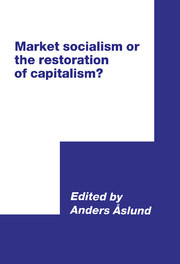Book contents
- Frontmatter
- Contents
- Notes on contributors
- Introduction
- Part I Market socialism revisited
- Part II Economic thinking and policy-making
- Part III Effects of perestroika on Soviet life
- 8 Employment and the reallocation of labour in the USSR
- 9 Changes in income inequality in the USSR
- 10 Estonia's economic development 1940–1990 in comparison with Finland
- Index
- SELECTED PAPERS FROM THE FOURTH WORLD CONGRESS FOR SOVIET AND EAST EUROPEAN STUDIES, HARROGATE, JULY 1990
10 - Estonia's economic development 1940–1990 in comparison with Finland
from Part III - Effects of perestroika on Soviet life
Published online by Cambridge University Press: 04 August 2010
- Frontmatter
- Contents
- Notes on contributors
- Introduction
- Part I Market socialism revisited
- Part II Economic thinking and policy-making
- Part III Effects of perestroika on Soviet life
- 8 Employment and the reallocation of labour in the USSR
- 9 Changes in income inequality in the USSR
- 10 Estonia's economic development 1940–1990 in comparison with Finland
- Index
- SELECTED PAPERS FROM THE FOURTH WORLD CONGRESS FOR SOVIET AND EAST EUROPEAN STUDIES, HARROGATE, JULY 1990
Summary
As a result of the annexations of Estonia by the Soviet Union in 1940 and 1944, a fundamentally new political and economic order was introduced. As in other parts of the Soviet Union the political system was dominated by the Communist Party and the system of Soviets. The economy was based on the Stalinist central planning system and the agriculture was collectivized. Gradually, Estonia also became an integral part of the all-union Soviet economy. During most of Estonia's independence period, the political and economic structures had to a large extent resembled that of the West European countries. The new social transformation was performed with extremely harsh methods, and the benefits of the reorganization were questioned by many Estonians from the outset. On the other hand, it was pointed out by the Soviet authorities that Estonia's economic development would prosper as a result of the integration into the Soviet economy. Also, the new system was said to be more advantageous for the working class which constituted a majority of the population.
During the Gorbachev era,-questions were more openly raised about the benefits of the social transformation inaugurated by the communists. In many cases, this development was considered detrimental to the social and economic performances of Estonia. In order to shed light on this problem, a comparative analysis will be carried out in this chapter, where the development of Estonia will be compared with other countries and the Soviet republics, and especially with its Northern neighbour, Finland.
- Type
- Chapter
- Information
- Market Socialism or the Restoration of Capitalism? , pp. 194 - 208Publisher: Cambridge University PressPrint publication year: 1991



